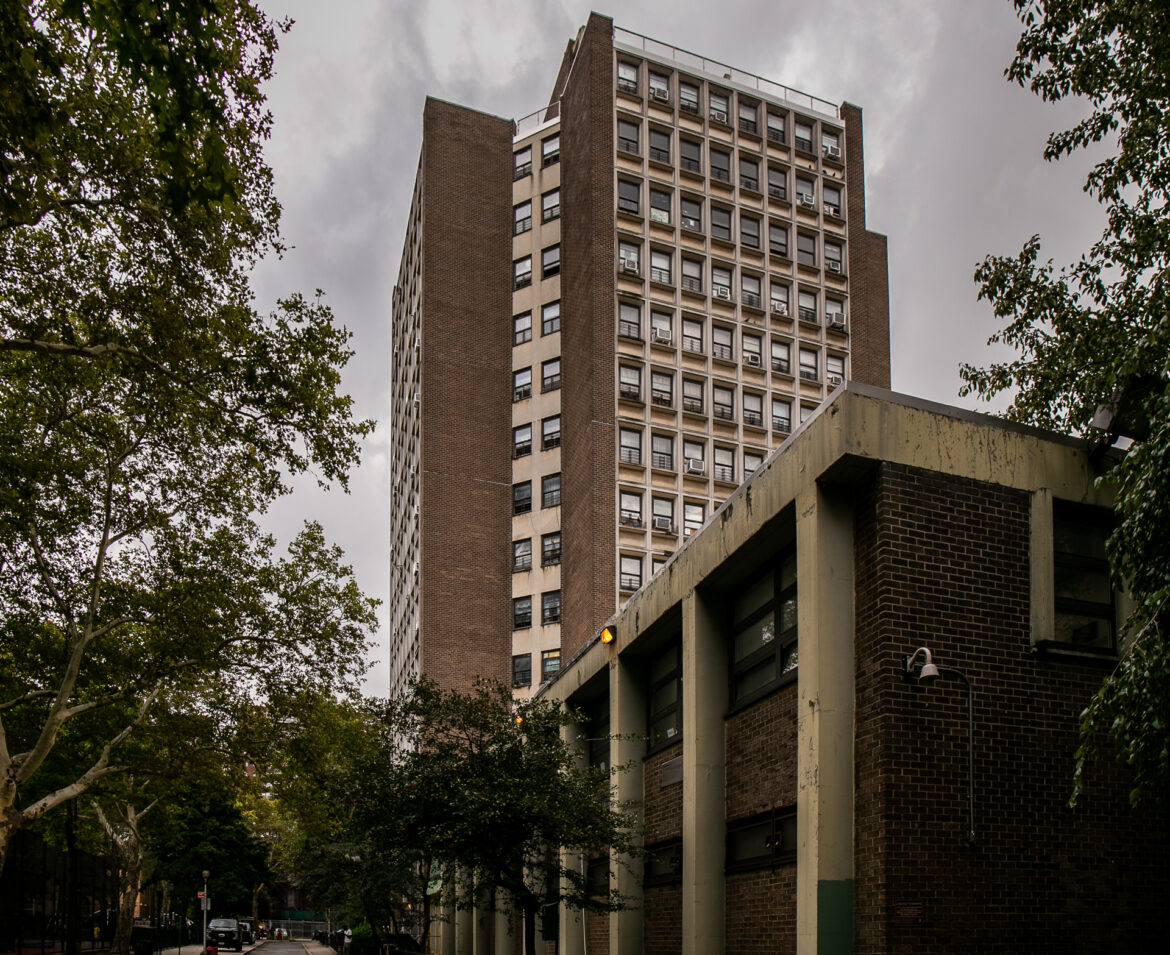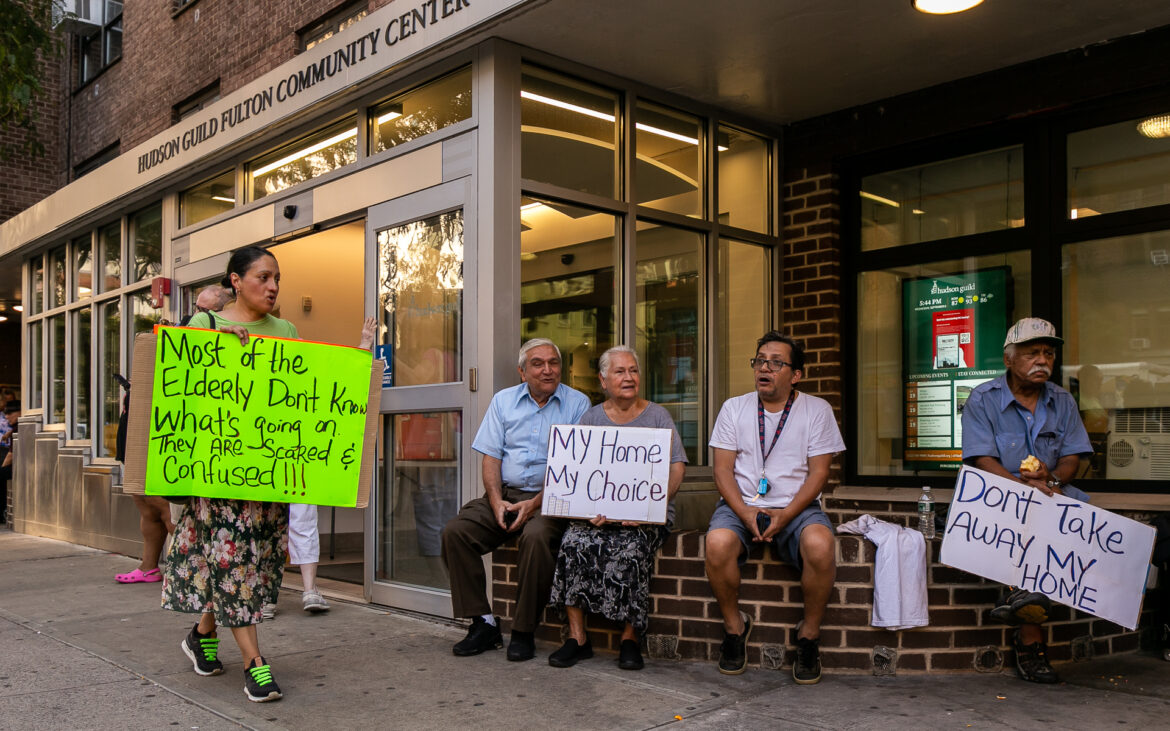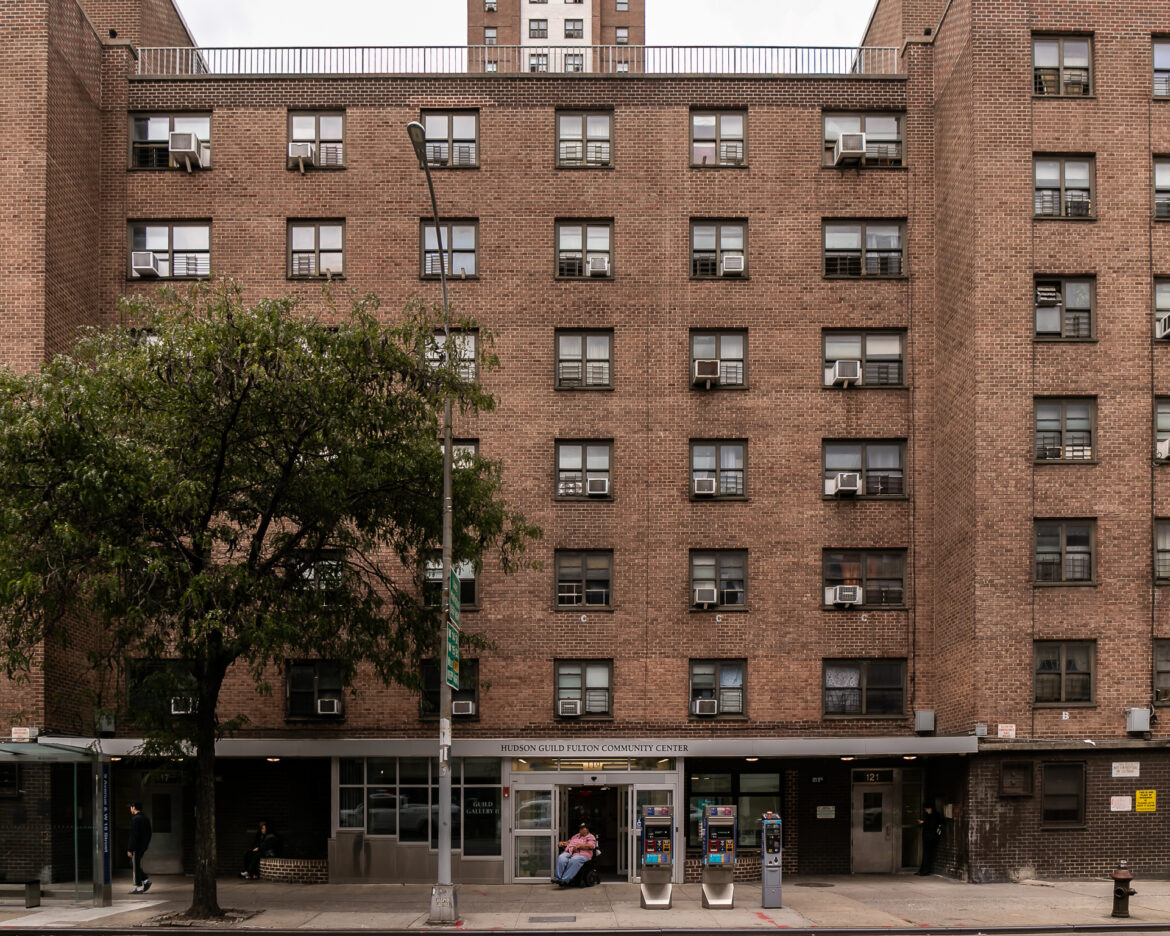Members of the housing authority’s board approved an agreement Wednesday that brings the razing and rebuilding of the Fulton and Elliott-Chelsea Houses closer to fruition, and kicks off a plan to provide tenants with repairs and upgrades while they wait.

Adi Talwar
NYCHA’s Chelsea Addition, on West 27th Street between 9th and 10th avenues, is among the first to be torn down under the rehab plan.A controversial proposal to demolish and entirely rebuild several downtown NYCHA complexes is another step closer to fruition.
Changes to the housing developments that make up the Fulton and Elliott-Chelsea Houses are part of the Permanent Affordability Commitment Together (PACT) program, an initiative that puts public housing properties under a third-party manager that takes on operational functions such as renovations, rent collection and repairs.
While PACT developments, once converted, typically see enhancements like new kitchens, bathrooms, playgrounds and security systems, NYCHA board members on Wednesday morning approved a plan that has yet to be taken on under the initiative: tearing entire buildings down.
For Fulton and Elliott-Chelsea, the PACT partners, Essence Development and Related Companies, have an ambitious proposal to demolish and rebuild all 2,056 existing units from scratch, while also adding 3,500 mixed-income units on NYCHA land.
Although the plan has been under discussion for roughly five years, the thumbs up from the board Wednesday means the housing authority can move ahead by entering into a Master Development Agreement—a comprehensive deal that lays out terms and conditions with the PACT partners involved.
The agreement, while spelling out the intricacies of the large scale project, will also have an immediate effect: as tenants wait for demolition, an initiative called the “Bridge Plan” will offer more security on site, pest control, building-wide and in-unit repairs, officials say. The “Bridge” is part of providing a “dignified transition,” to tenants, one of seven pillars outlined in the Master Development Agreement.
“We are pleased to be able to begin this critical work for residents that will provide immediate quality of life improvements until we can complete the comprehensive development plan—that will bring new and safe housing these NYCHA residents deserve,” said Essence Development Founder Jamar Adams.
But as the process moves forward, residents have voiced a mix of emotions ranging from excitement to deep concern about the possible next phase for their homes, and some remain strongly opposed to demolition.

Adi Talwar
Tenants protesting NYCHA’s demolition plans outside the Fulton Community Center in September 2023.In the minutes leading up to the board’s vote on Wednesday, speakers went to the mic to voice their opinion and in some cases, make a plea for more time.
Celines Miranda, a resident of Elliott Houses, held a yellow envelope in her hand. In it, she said, were signatures of close to 940 tenants who signed a petition against the demolition and reconstruction, collected by a group of tenants through door-knocking.
“We implore, we demand and we stand firm in uniting against the demolition of our homes,” said Miranda. “Please do not support a plan that would cause so much hurt, pain and destruction to our NYCHA homes and broader community of Chelsea who will also be affected.”
Moments after, Daniel Ramirez, a resident of the Fulton Houses for 26 years, raised concerns about the decision making process. “They didn’t ask me if I agreed to demolish the place I live,” said Ramirez in Spanish. “No one has the right to vote for me.”
Are you a student, tenant or worker in the Chelsea neighborhood? What are your thoughts on the proposal? Tell us! Email Tatyana@citylimits.org.
NYCHA announced last June that a majority of residents who participated in a survey to gauge their thoughts on various PACT development plans opted for a fresh start, voting to tear down existing properties and construct new ones.
A breakdown of the survey results, published in April by Manhattan Community Board 4’s Land Use Committee, showed that 37 percent of eligible households and 29 percent of eligible residents weighed in.
Of the 969 responses received, 43 percent chose rehabilitation of existing units while 57 percent selected “full replacement of existing units”—which tenants have criticized for being unclear, as the phrasing does not specify demolition.
Traditionally, PACT developments see renovations that take roughly two to three years. Construction work might consist of uplifts to outdoor spaces like playground and basketball courts, as well as apartment upgrades such as new kitchens and bathrooms.
However, creating a brand new campus would be the first of its kind for PACT. In a slideshow presented by NYCHA’s Executive Vice President for Real Estate Development, Jonathan Gouveia, the scope of work in the new buildings will include amenities such as an in-unit washer and dryer, resident controlled heating, cooling and ventilation, and rooftop space.
The new construction would also come with new storefronts for uses such as community centers, healthcare facilities and grocery stores.
“In summary, for the first time, NYCHA would be able to create a complete community with mixed uses and mixed incomes to better serve our residents with brand new apartments and supporting amenities and services and expand the city’s supply of affordable housing,” Gouveia said.
But to Jackie Lara, a resident at the Fulton Houses, a home is more than those conveniences. “We didn’t sign up for our homes to be turned into high-rise luxury apartments, wiping out the history and character of Chelsea,” she said.
Miguel Acevedo, the tenant association president at Fulton Houses, argued that a clean slate is what the housing development needs. He was the last tenant to give a comment Wednesday. The resident leader brought up frustrations like inconsistent maintenance work, “disgusting elevators” and recent crimes at other NYCHA campuses.
“That’s why this proposal has to get done,” Acevedo said. “I’ve been at Fulton since the very beginning and to hear from the community who don’t want it done because ‘not in my backyard’…no, in your backyard, because eventually it has to get done because we shouldn’t be living this way anymore.”
In an effort to minimize disruption, 94 percent of residents will be able to stay in their apartment as new buildings are being constructed.
However, tenants living in Fulton 11 and Chelsea Addition, making up roughly 120 households, may be temporarily relocated while their new homes rise. The two buildings are slated to be torn down first, and impacted residents will be moved into vacant units throughout the campus. In the event a unit of an appropriate size is unavailable, residents will either move to a privately managed building in the community or another NYCHA development.

Adi Talwar
The senior center at NYCHA’s Fulton Houses.“Per HUD requirements, any household that is temporarily relocated off-site will have the right to return to their development once the associated NYCHA Replacement Building is complete,” said Gouveia during the presentation. “The PACT partner will be responsible for providing relocation assistance and the payment of any costs related to packing and on-or-off-site relocations.”
Jamie Rubin, the chairman of NYCHA’s board, said in a statement that approving the agreement, which highlights other principles such as using a “build first” model and undertaking “comprehensive and equitable planning,” was not taken lightly.
“Fulton and Elliott-Chelsea residents can expect in the coming years that they will live in safe and permanently affordable housing thanks to the work their neighbors and NYCHA have put into crafting this plan,” Rubin said. “The Board was pleased to approve an important next step in NYCHA’s transformation.”
Should the U.S. Department of Housing and Urban Development (HUD) approve the environmental review for the plan next year, the first two buildings can begin work within the current zoning regulations, according to NYCHA.
But some tenants said they will continue to push back.
“We have built this community, we were born here, we went to school here and we are taking care of our parents here,” said Renee Keitt, a tenant at the Elliott Houses. “As always, no demolition to Fulton and Elliott-Chelsea Houses.”
To reach the reporter behind this story, contact Tatyana@citylimits.org. To reach the editor, contact Jeanmarie@citylimits.org
Want to republish this story? Find City Limits’ reprint policy here.









2 thoughts on “NYCHA Board Green Lights Plan to Demolish & Rebuild Lower Manhattan Developments”
This article gives readers the impression that there’s overwhelming resident support for the demolition plan, when in reality, only a small portion of residents participated, let alone supported this outcome.
Let’s break down the actual survey numbers that are being misrepresented. Only 18% of eligible households (550 out of 3,388) expressed support for new construction. That’s a far cry from a majority opinion. Moreover, only 29% of eligible residents responded to the survey overall, with even lower percentages (32% at Fulton Houses and 24% at Elliott-Chelsea) showing support for demolition. This low response rate alone should prompt questions about the transparency and adequacy of the survey’s distribution and why it took eleven months — and multiple Freedom of Information requests — for the data to be released.
The article also fails to address the glaring inconsistency of spending on repairs under a “Bridge” plan that appears poised to lead to demolition anyway. It’s puzzling that funding has escalated from $366 million to $1.2 billion, with no clear explanation for this ballooning cost. Why would they allocate resources to repair buildings that they plan to demolish? This raises critical questions about wasteful spending, poor planning, and whether these plans are genuinely resident-driven, as NYCHA claims.
When so few residents support this direction, it’s not just misleading but harmful to paint this as a “majority” choice. Our lives and homes are at stake, and this process deserves deeper scrutiny. The numbers tell a different story than the one reported. An accurate account of resident sentiment and the troubling lack of transparency in this process needs to be highlighted. Once again you fail to do so. This is a deliberate attempt to unhouse families through urban renewal. Your readers deserve to know the full story, not a version that smooths over NYCHA’s narrative.
Accurately covering the demolition and disposition of public housing requires an understanding of the specific procedures involved. When reporting on this, journalists have a responsibility to convey how these processes work rather than simply echoing agency statements, as doing so can lead to misleading headlines and underreported issues.
Finally. Rebuild.